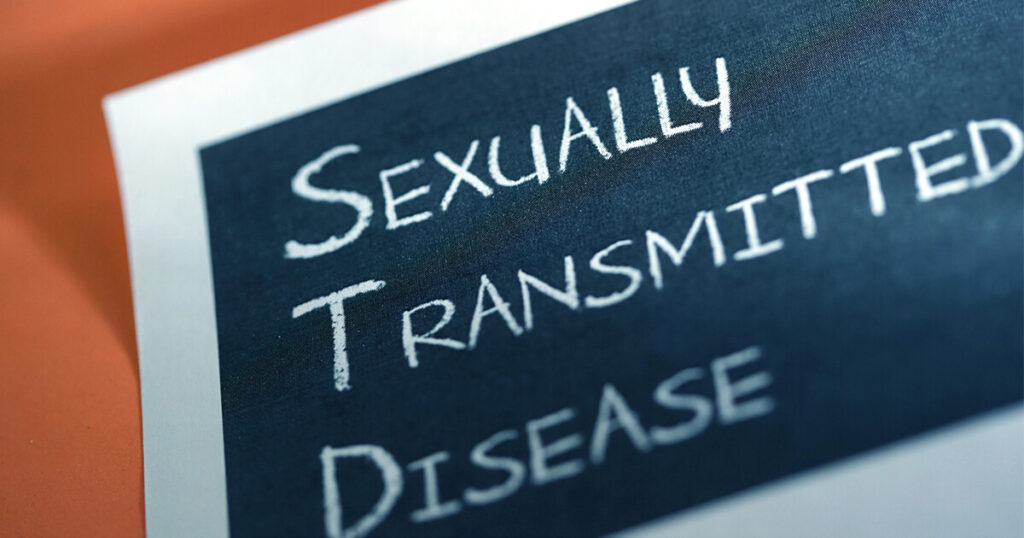Sexually transmitted diseases (STDs) are infections that can be transmitted through sexual contact with an infected individual. These are also termed sexually transmitted infections or STIs. STDs can be transmitted during vaginal or other types of sexual intercourse including oral and anal sex, but some are acquired simply by skin-to-skin contact.
List of contents
1. What causes sexually transmitted diseases (STDs)?
3. Who is affected by sexually transmitted diseases (STDs)?
4. What are the symptoms of sexually transmitted diseases (STDs)?
5. How do I know if I have an STDs?
6. How are sexually transmitted diseases (STDs) diagnosed?
8. What are the treatments for sexually transmitted diseases (STDs)?
What causes sexually transmitted diseases (STDs)?
STDs can be caused by over 20 different types of organisms, including:
- Viruses such as HIV, hepatitis B, herpes simplex and human papillomavirus (HPV)
- Bacteria such as gonorrhea, chlamydia, and syphilis
- Parasites like Trichomonas
STDs develop when various bacteria, viruses or parasites infect your body. People share these microorganisms through bodily fluids during sexual activity — usually vaginal, oral or anal sex. STDs like syphilis can be transmitted to an unborn child and people who share infected drug needles can pass on STDs.
Who is at risk?
The primary risk factor for an STD is unprotected sexual intercourse or contact. It is important to know that all people with an STD do not have symptoms. The highest risk is for certain groups which include:
- Those with multiple sex partners, or whose partners have sex with multiple others
- Individuals in non-monogamous relationships who do not use condoms during sex and their partners
- Commercial sex workers
- Drug abusers, especially those who drink and use injectable drugs, because they tend to practice high-risk sexual behavior
- Children of infected mothers through vertical transmission
Who is affected by sexually transmitted diseases (STDs)?
Most STDs affect both men and women, but in many cases the health problems they cause can be more severe for women. If a pregnant woman has an STD, it can cause serious health problems for the baby.
What are the symptoms of sexually transmitted diseases (STDs)?
STDs don’t always cause symptoms or may only cause mild symptoms. So it is possible to have an infection and not know it. But you can still pass it on to others.
The symptoms of STDs vary with the type of infection. If there are symptoms, they could include:
- Unusual discharge from the penis or vagina
- Painful or frequent urination
- Itching and redness in the genital area
- Blisters or sores in or around the mouth
- Vaginal discharge that has a bad odor, causes irritation or is a different color or amount than usual.
- Vaginal bleeding that’s not your period.
- Anal itching, soreness, or bleeding
- Abdominal painn
- Aches, pains, fever and chills.
- Pain experienced during sexual intercourse or while urinating. The pain may be of a stabbing or burning nature or dull pain in the pelvic area.
- Pain in and around the anus. Similarly, there may be sores and pain in the mouth in those who have oral sex with an infected person.
- There may be blisters around the genital area that turn into scabs.
- There may also be soft, flesh-colored warts around the genital area.
- There may be a scaly rash over the palms of the hand and soles of the feet or the trunk.
- In the case of hepatitis, urine may appear dark and stools light and chalky color. The whites of the eyes, nail beds and skin may also become a yellowish color.
- General symptoms of some STIs include fever, weakness, body and muscle aches and swollen lymph nodes.
- In people with HIV infection that has progressed to AIDS, weight loss, recurrent infections, night sweats, and tiredness may be present.
Depending on the type of infection, the STD may present either soon after exposure, within a few days, or may take years to manifest.
How do I know if I have an STDs?
You may have uncomfortable symptoms, such as genital itching, burning or discharge.
Make an appointment to see your healthcare provider and explain that you think you might have an STD. Your healthcare provider can examine you to figure out if you have an infection. They’ll ask about your symptoms and sexual history — answer honestly, so you can get the help you need.
How are sexually transmitted diseases (STDs) diagnosed?
If you are sexually active, you should talk to your health care provider about your risk for STDs and whether you need to be tested. This is especially important since many STDs do not usually cause symptoms.
Some STDs may be diagnosed during a physical exam or through microscopic examination of a sore or fluid swabbed from the vagina, penis, or anus. Blood tests can diagnose other types of STDs.

What’s STDs testing like?
The STDs test you need depends on the type of STD you may have. Your provider will talk to you about what tests you need. STD testing includes:
- Urine test.
- Cheek swab.
- Blood test.
- Exam of your genital area.
- Testing a fluid sample from sores.
- Testing discharge or cell samples from your body (usually the vagina, urethra, cervix, penis, anus or throat).
What are the treatments for sexually transmitted diseases (STDs)?
The recommended treatment for STDs varies, depending on what STD you have. It’s very important that you and your sexual partner be successfully treated for STDs before resuming sexual activity. Otherwise, you can pass an infection back and forth between you.
Bacterial STDs
Usually, antibiotics can easily treat bacterial infections. It’s important to take all your antibiotics as prescribed. Continue taking them even if you feel better before you finish taking all of them. Let your doctor know if your symptoms don’t go away or return after you’ve taken all of your prescribed medication.
Viral STDs
Antibiotics can’t treat viral STDs. While most viral infections have no cure, some can clear on their own. And in many cases, treatment options are available to relieve symptoms and reduce the risk of transmission.
For example, medications are available to reduce the frequency and severity of herpes outbreaks. Likewise, treatment can help stop the progression of HIV. Furthermore, antiviral drugs can lower your risk of transmitting HIV to someone else.
Other STDs
Some STDs are caused by neither viruses nor bacteria. Instead, they’re caused by other small organisms. Examples include: pubic lice, trichomoniasis, scabies
These STDs are usually treatable with oral or topical medications. Ask your doctor or other healthcare provider for more information about your condition and treatment options.
Complications of STDs
People with STDs may experience complications like:
- Pain in the pelvis
- Pregnancy complications including miscarriage, stillbirths and fetal anomalies
- Inflammation of the eyes, joints
- Heart and blood vessel disease
- Infertility
- PID
- Cancer of the cervix, throat, rectum and other areas due to HPV infection

Can Sexually Transmitted Disease be prevented?
Avoiding sexual contact is the only foolproof way to avoid STDs. But when having vaginal, anal, or oral sex, there are ways to make it safer.
- When used properly, condoms provide effective protection against many STDs. For optimal protection, it’s important to use condoms during vaginal, anal, and oral sex. Dental dams can also provide protection during oral sex. Condoms are generally effective at preventing STDs that spread through fluids, such as semen or blood. But they can’t fully protect against STDs that pass from skin to skin. If a condom doesn’t cover the area of skin with the infection, a person can still contract an STD or pass it to their partner.
- Before having sex with a new partner, it’s important to discuss sexual history. Partners should also be screened for STDs by a healthcare professional. Since STDs often have no symptoms, testing is the only way to know for sure if someone has one.
- When discussing STD test results, it’s important to ask a partner what they’ve been tested for. Many people assume their doctors have screened them for STDs as part of their regular care, but that’s not always true. need Ask the doctor for specific STD tests to ensure they’re taken.
- If a sexual partner tests positive for an STD, it’s important for them to follow their healthcare provider’s recommended treatment plan. You can also ask your doctor about strategies to protect yourself from contracting the STD from your partner. For example, if your partner has HIV, your doctor will likely encourage you to take pre-exposure prophylaxis (PrEP).
- If you’re eligible, you and your partner should also consider getting vaccinated for HPV and hepatitis B.
Sexually Transmitted Disease are preventable
If you have sex, know how to protect yourself and your sexual partner from STDs.
- Bacterial Vaginosis: Any woman can get bacterial vaginosis. Having bacterial vaginosis can increase your chance of getting an STD.
- Chancroid: Chancroid is a bacterial condition that causes open sores on or around the genitals. It’s a type of sexually transmitted infection (STI), which means it’s transmitted through sexual contact.
- Chlamydia: Chlamydia is a common sexually transmitted disease (STD) that can be easily cured. If left untreated, chlamydia can make it difficult for a woman to get pregnant.
- Gonorrhea: Anyone who is sexually active can get gonorrhea. Gonorrhea can cause very serious complications when not treated, but can be cured with the right medication.
- Hepatitis: Viral hepatitis is the leading cause of liver cancer and the most common reason for liver transplantation.
- Herpes: Genital herpes is a common STD, and most people with genital herpes infection do not know they have it.
- HIV/AIDS: People who have STDs are more likely to get HIV, when compared to people who do not have STDs.
- Human Papillomavirus (HPV) Infection: Human papillomavirus (HPV) is the most common sexually transmitted infection in the United States. Some health effects caused by HPV can be prevented with vaccines.
- Pelvic Inflammatory Disease (PID): Pelvic Inflammatory Disease (PID) can lead to serious consequences including infertility.
- Syphilis: Syphilis is a sexually transmitted disease (STD) that can have very serious complications when left untreated, but it is simple to cure with the right treatment.
- Trichomoniasis: Most people who have trichomoniasis do not have any symptoms.
- Scabies: Scabies is a skin infestation caused by a mite known as the Sarcoptes scabiei. Untreated, these microscopic mites can live on your skin for months. They reproduce on the surface of your skin and then burrow into it and lay eggs. This causes an itchy, red rash to form on the skin.
References
Diseases & Related Conditions
- cdc.gov/std/general/default.htm
Sexually Transmitted Diseases
- medlineplus.gov/sexuallytransmitteddiseases.html
What is an STD?
- news-medical.net/health/What-is-an-STD-(Sexually-Transmitted-Disease).aspx
Everything You Need to Know About Sexually Transmitted Diseases (STDs)
- healthline.com/health/sexually-transmitted-diseases#curable-stds
Sexually Transmitted Diseases & Infections (STDs & STIs)
- my.clevelandclinic.org/health/diseases/9138-sexually-transmitted-diseases–infections-stds–stis

